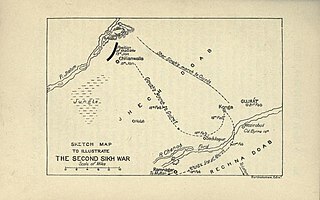
The Second Anglo-Sikh War was a military conflict between the Sikh Empire and the East India Company which took place from 1848 to 1849. It resulted in the fall of the Sikh Empire, and the annexation of the Punjab and what subsequently became the North-West Frontier Province, by the East India Company.
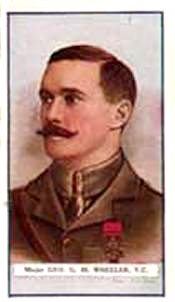
George Godfrey Massy Wheeler, VC was a British Army officer, and a recipient of the Victoria Cross, the highest and most prestigious award for gallantry in the face of the enemy that can be awarded to British and Commonwealth forces.

The Governor General's Bodyguard was a cavalry regiment of the British Indian Army and served as the British Indian equivalent to the Household Cavalry of the British Army.

The Battle of Aliwal was fought on 28 January 1846 between the British and Sikh forces in northern India. The British were led by Sir Harry Smith, while the Sikhs were led by Ranjodh Singh Majithia. Britain's victory in the battle is sometimes regarded as the turning point in the First Anglo-Sikh War.

The Battle of Gujrat was a decisive battle in the Second Anglo-Sikh War, fought on 21 February 1849, between the forces of the East India Company, and a Sikh army in rebellion against the company's control of the Sikh Empire, represented by the child Maharaja Duleep Singh who was in British custody in Lahore. The Sikh army was defeated by the British regular and Bengal Army forces of the British East India Company. After it capitulated a few days later, the Punjab was annexed to the East India Company's territories and Duleep Singh was deposed.
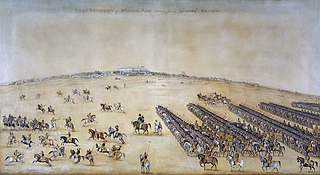
The 1st Horse (Skinner's Horse) is a regiment of the Armoured Corps of the Indian Army. It traces its origins as a cavalry regiment from the times of the East India Company, followed by its service in the British Indian Army and finally, after independence as the fourth oldest and one of the senior cavalry regiments of the Armoured Corps of the Indian Army.
The 6th King Edward's Own Cavalry was a cavalry regiment in the Bengal Army (1842–1895) and the British Indian Army (1895–1921) until it was amalgamated with the 7th Hariana Lancers to form the 18th King Edward's Own Cavalry.

The 14th Murray's Jat Lancers, also sometimes known as the Murray's Jat Horse, was a cavalry regiment of the British Indian Army. In 1921 it was renamed as 20th Lancers, and after Partition of India in 1947 it eventually became 20 Lancers (India) as an armoured regiment of the Indian Army. Its muslim soldiers were retained in the regiment which is now known as the 20th Lancers (Pakistan).
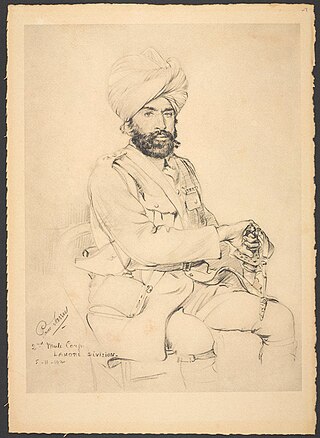
The 3rd (Lahore) Division was an infantry division of the Indian Army and before 1895, the Bengal Army, first organised in 1852. It saw service during World War I as part of the Indian Corps in France before being moved to the Middle East where it fought against troops of the Ottoman Empire.

The 5th Horse is an armoured regiment of the Pakistan Army. It was previously known as the 5th King Edward's Own Probyn's Horse, which was a regular cavalry regiment of the British Indian Army. It was formed in 1921 by the amalgamation of the 11th King Edward's Own Lancers (Probyn's Horse) and the 12th Cavalry.
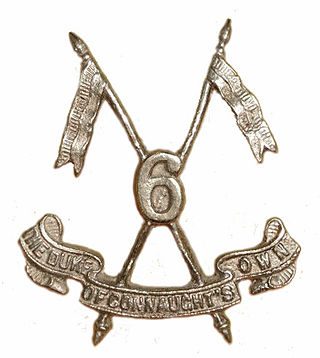
The 6th Lancers is an armoured regiment of the Pakistan Army. Previously, it was known as the 6th Duke of Connaught's Own Lancers (Watson's Horse), and was a regular cavalry regiment in the British Indian Army. It was formed in 1921 by amalgamation of the 13th Duke of Connaught's Lancers (Watson's Horse) and the 16th Cavalry. The regiment and its predecessors have seen active service on the North West Frontier, in Egypt during 1882, in China during the Boxer Rebellion, the two World Wars and the Indo-Pakistani War of 1965. On the Partition of India in 1947, the regiment was allotted to the Pakistan Army, where it remains in service today.
The 7th Light Cavalry previously the 28th Light Cavalry, was a regular army cavalry regiment in the British Indian Army. It was raised in 1784 under the East India Company. The regiment later saw service on the North West Frontier and in World War I and World War II. In 1947, it was allocated to the new Indian Army, where it continues to exist as the 7th Light Cavalry
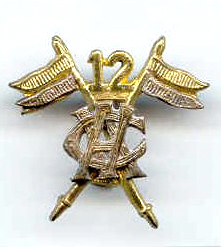
The 12th Cavalry Sam Browne's Cavalry (Frontier Force) is an armoured regiment of Pakistan Army. It was formed in the British Indian army in 1922 by the amalgamation of 22nd Sam Browne's Cavalry (Frontier Force) and 25th Cavalry (Frontier Force).
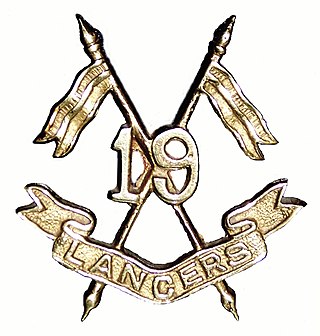
The 19th Lancers is an armoured regiment of the Pakistan Army. Before 1956, it was known as 19th King George V's Own Lancers, which was a regular cavalry regiment of the British Indian Army. It was formed in 1922, by the amalgamation of 18th King George's Own Lancers and 19th Lancers (Fane's Horse). On Partition of India in 1947, the regiment was allotted to Pakistan.
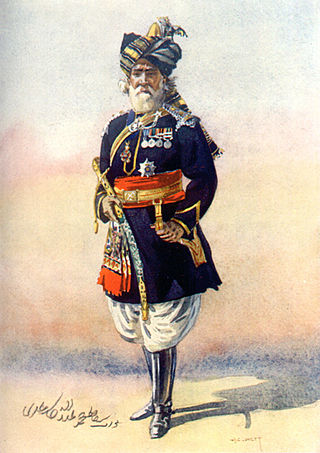
The 15th Lancers was a cavalry regiment of the British Indian Army which existed from 1858 to 1921. Raised during the 1857 uprising, the regiment later saw service in the Second Afghan War of 1878–80 and the First World War. The regiment was one of the single class regiments, with all troops being recruited from the Punjab.
The 18th Cavalry is a cavalry regiment of the armoured corps of the Indian Army. The regiment was created in 1921, as the 18th King Edward's Own Cavalry of the British Indian Army, through the amalgamation of the 7th Hariana Lancers and 6th King Edward's Own Cavalry.

The 13th Lancers is an armoured regiment of Pakistan Army. It was formed in 1923 as 13th Duke of Connaught's Own Lancers by the amalgamation of 31st Duke of Connaught's Own Lancers and 32nd Lancers. On Partition of India in 1947, the regiment was allotted to Pakistan.

The Battle of Shaiba was a battle of World War I fought between British and Ottoman forces, the latter trying to retake the city of Basra from the British.

The 6th Indian Cavalry Brigade was a cavalry brigade of the British Indian Army that saw active service in the Indian Army during the First World War. It took part in the Mesopotamian campaign and was broken up soon after the end of the war.
The 20th Lancers was a regiment of the British Indian Army.

















